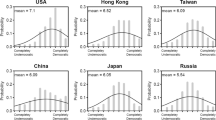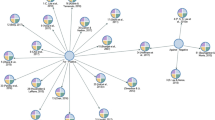Abstract
The mathematical theory of democracy is applied to analyze the German Bundestag elections 2009 and to evaluate five German leading parties and their coalitions from the viewpoint of direct democracy. For this purpose, the positions of the parties on over 30 topical issues are compared with results of public opinion polls. The outcomes are summarized in the party indices of popularity (the average percentage of the population represented) and universality (frequency of representing a majority). It is shown that the election winner 2009, the conservative party CDU/CSU, has a quite low representativeness (ranked fourth), whereas the most representative is the left party die Linke which received only 11.9% votes. It is concluded that voters are not very consistent with their own political profiles, disregard party manifestos, and are likely driven by political traditions, even if outdated, or by personal images of politicians. To bridge approaches of representative and direct democracy, some modifications to the election procedure are proposed, which, among other things, complicate vote manipulations.
Similar content being viewed by others
References
Abramowitz M, Stegun I (1972) Handbook of mathematical functions. Dover, New York
Achen Ch (1977) Measuring representation: perils of the correlation coefficient. Am J Political Sci 21: 805–815
Achen Ch (1978) Measuring representation. Am J Political Sci 22: 475–510
Antidiskriminierungsstelle des Bundes (2010) Modellprojekt zu anonymisierten Bewerbungsverfahren in Deutschland
Berghammer R, Rusinowska A, de Swart HCM (2007) Applying relational algebra and RelVieW to coalition formation. Eur J Oper Res 178: 530–542
Black D (1958) The theory of committees and elections. Cambridge University Press, Cambridge
Brams SJ, Kilgour DM, Zwicker WS (1998) The paradox of multiple elections. Soc Choice Welf 15: 211–236
Brink, C, Kahl, W, Schmidt, G (eds) (1997) Relational methods in computer science. Springer, Berlin
Bundeswahlleiter (2009) Ergebnisse der Wahl zum 17. Deutschen Bundestag. http://www.bundeswahlleiter.de/de/bundestagswahlen/BTW_BUND_09/
Bundeszentrale für politische Bildung (2010) Wahl-O-Mat. http://www.bpb.de/methodik/XQJYR3
Castor-Transport geht auf schwierigste Etappe (2010) DW-World.De, 2010, 7 November. http://www.dw-world.de/dw/article/0,,6200664,00.html
de Vries M (1999) Governing with your closest neighbour: an assessment of spatial coalition formation theories. University of Nijmegen, Print Partners Ipskamp. http://hdl.handle.net/2066/18833
Held D (1996) Models of democracy, 2nd edn. Polity Press, Cambridge
Hölzlein M (2010) Evaluation of German parliamentary election 2009 by methods of mathematical theory of democracy and extension to electorate’s opinion profile. Karlsruhe Institute of Technology, January 2010
Institute for Public and Politics (2010) StemWijzer. http://www.stemwijzer.nl/
Jackson JE (1988) A user’s guide to principal components. Wiley, New York
Korn GA, Korn ThM (1968) Mathematical handbook for scientists and engineers. McGraw-Hill, New York
Krause A, Rinne U, Zimmermann KF (2010) Anonymisierte Bewerbungsverfahren. Bonn, IZA Research Report No. 27
Krzanowski WJ (1988) Principles of multivariate analysis. Oxford University Press, Oxford
Manin B (1997) The principes of representative government. Cambridge University Press, Cambridge
Miller WE (1964) Majority rule and the representative system of government. In: Allardt E, Littunen Y (eds) Cleavages, ideologies, and party systems. Trans Westermarck Soc, pp 343–376
Miller NR (1983) Pluralism and social choice. Am Political Sci Rev 77: 734–747
Mueller DC (1989) Public choice II. Cambridge University Press, Cambridge
Pitkin H (1967) The concept of representation. University of California Press, Berkeley
Protest gegen Stuttgart 21 (2010) Wikipedia http://de.wikipedia.org/wiki/Protest_gegen_Stuttgart_21
Roemer J (1998) Why the poor do not expropriate the rich: an old argument in new garb. J Public Econ 70(3): 399–424
Rusinowska A, de Swart H, van der Rijt JW (2005) A new model of coalition formation. Soc Choice Welf 24: 129–154
Rusinowska A, Berghammer R, Eklund P, Rijt JW van der, Roubens M, de Swart HCM (2006) Social software for coalition formation. In: de Swart HCM, Orlowska E, Schmidt G, Roubens M (eds) Theory and applications of relational structures as knowledge instruments II. Lecture notes in artificial intelligence (LNAI) vol 4342. Springer, Heidelberg, pp 1–30.
Samons LJ II (2004) What’s wrong with democracy?. University of California Press, Berkeley
Schmidt G, Ströhlein T (1993) Relations and graphs, discrete mathematics for computer scientists. Springer, Berlin
Seber GAF (1984) Multivariate observations. Wiley, New York
Tangian (Tanguiane) A (1991) Aggregation and representation of preferences. Introduction to mathematical theory of democracy. Springer-Verlag, Berlin
Tangian A (2007) Selecting predictors for traffic control by methods of the mathematical theory of democracy. Eur J Oper Res 181: 986–1003
Tangian A (2008a) A mathematical model of Athenian democracy. Soc Choice Welf 31: 537–572
Tangian A (2008b) Predicting DAX trends from Dow Jones data by methods of the mathematical theory of democracy. Eur J Oper Res 185: 1632–1662
Tangian A (2010a) Application of the mathematical theory of democracy to Arrow’s impossibility theorem (How dictatorial are Arrow’s dictators?). Soc Choice Welf 35(1): 135–167
Tangian A (2010b) Evaluation of German parties and coalitions by methods of the mathematical theory of democracy. Eur J Oper Res 202: 294–307
van Deemen A (1997) Coalition formation and social choice. Kluwer, Dordrecht
Wright GC Jr. (1978) Candidates’ policy positions and voting in U.S. congressional elections. Legislative Stud Quar 3: 445–464
Author information
Authors and Affiliations
Corresponding author
Rights and permissions
About this article
Cite this article
Tangian, A. German parliamentary elections 2009 from the viewpoint of direct democracy. Soc Choice Welf 40, 833–869 (2013). https://doi.org/10.1007/s00355-011-0646-y
Received:
Accepted:
Published:
Issue Date:
DOI: https://doi.org/10.1007/s00355-011-0646-y




